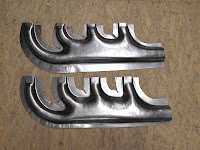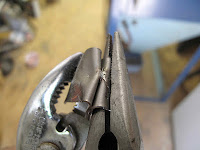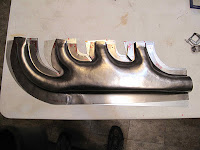The bottom part is the first one I've made with the changes to the blank template and form block. I like it. It has a very even width to the flange. It is wide enough to trim and fold over the other half. The corners dis not tear out and the flange is wide enough even in the corners. There is plenty of straight section at the inlets so they can be trimmed to fit the flanges. I think I'll make one more before I make the new form block from the ash I bought.
This is great!
Tuesday, June 11, 2013
Sunday, June 9, 2013
Spot Welder To Weld The Exhaust Manifold Shells Together
The other day my neighbor, Galen, stopped by to pick up some embroidery. While his family patiently waited I showed him the progress on the various airplane projects and my efforts to make gas spot weld for the manifolds.. He said they had just stopped at Harbor Freight and saw a spot welder on sale. I've generally avoided Harbor Freight because a fair amount of the tools they sell are just too cheesy for words. At the same time they can have some cheap deals which I'll admit has a certain appeal to me. The welder was on sale for $179 so we drove the 40 miles to the nearest one and bought the welder. My general opinion of their tools hasn't changed as a result, but I couldn't find anything close on line and I don't have a lot of welds to make.
I bought the 230 v model, same price as 120 v model, since I have the attic wired for it. It doesn't come with a plug so I stopped at Lowe's and got one to match my outlets. The rest of the assembly was simple. It's all metric, think Chinese, and you need a 6 mm Allen wrench to install the copper Prongs.
The idea is you adjust the position of the top prong so you get the pressure you want when the handle is closed against the stop bolt, below the back of the handle. Then you flip the switch under the handle until the weld is done, as soon as you see red. Spot weld spatter, were eye protection. The problem I had was that the top prong either is the wrong one or they've started just using the bottom prong for both. I didn't want to wait for their help line to be open to solve the problem so I modified the top prong.
The bottom prong is bent with a 90 degree bend. The instruction sheet shows the top prong bent 90 degrees at the end but 2 other bends so that the ends are coaxial when closed for welding. You want both electrodes square to the metal you're welding for good current flow. Also, I could not get the electrodes to close and the handle to close to the stop. The bends solved the problems and it welds great.
One of the things we did at AC Spark Plug to control spot welds, and assure they always formed, was to put a bump on one of the parts being welded. It controls where the weld forms, that you have metal to metal contact, creates a hot spot to start the weld, and allows you to position the weld with very blunt electrodes which last longer and are easier to make. I used my Whitney punch with a 3/32" punch and 5/32" die to make these 2 samples on the right. You want a bump of about 1/2 to 1 material thickness. Anywhere between these 2 samples will work fine. You also want just enough pressure on the electrodes to get good current flow, not to mash into the weld puddle.
A good weld should tear out of the steel, not separate. I finally gave up trying to tear my samples apart. The welds are very strong.
I bought the 230 v model, same price as 120 v model, since I have the attic wired for it. It doesn't come with a plug so I stopped at Lowe's and got one to match my outlets. The rest of the assembly was simple. It's all metric, think Chinese, and you need a 6 mm Allen wrench to install the copper Prongs.
The idea is you adjust the position of the top prong so you get the pressure you want when the handle is closed against the stop bolt, below the back of the handle. Then you flip the switch under the handle until the weld is done, as soon as you see red. Spot weld spatter, were eye protection. The problem I had was that the top prong either is the wrong one or they've started just using the bottom prong for both. I didn't want to wait for their help line to be open to solve the problem so I modified the top prong.
The bottom prong is bent with a 90 degree bend. The instruction sheet shows the top prong bent 90 degrees at the end but 2 other bends so that the ends are coaxial when closed for welding. You want both electrodes square to the metal you're welding for good current flow. Also, I could not get the electrodes to close and the handle to close to the stop. The bends solved the problems and it welds great.
One of the things we did at AC Spark Plug to control spot welds, and assure they always formed, was to put a bump on one of the parts being welded. It controls where the weld forms, that you have metal to metal contact, creates a hot spot to start the weld, and allows you to position the weld with very blunt electrodes which last longer and are easier to make. I used my Whitney punch with a 3/32" punch and 5/32" die to make these 2 samples on the right. You want a bump of about 1/2 to 1 material thickness. Anywhere between these 2 samples will work fine. You also want just enough pressure on the electrodes to get good current flow, not to mash into the weld puddle.
A good weld should tear out of the steel, not separate. I finally gave up trying to tear my samples apart. The welds are very strong.
Saturday, June 8, 2013
Changes to Manifold Shell Blank and Tools
Now that I've made 3 shell halves I can see where I need to make some changes to the layout of the blank. I need to have enough steel left along the edges to weld and fold over. I also don't want a lot of extra steel. I marked up a shell with changes to make. The blank under it has the changes.
You can see in the other 2 pictures most of the changes added some steel, especially at the inlets. The inlets all shortened as the steel was stretched because there is no way to hold the end and make it easy to form into a rectangle.
The only area where the edge was reduced was the bottom edge where the forward inlet tube enters the collector. That area wrinkled but never pulled into the form block so I reduced it a little.
I had left an area in the center layer to act as a stop for forming the rectangular inlets. It was beaten back into sawdust so that was just a dumb idea. It might have worked if I had wedged a support block under it, but I doubt it. Because I made the inlets longer, to allow for more shrinkage, I had to cut all that out anyway. I made some blocks from an ash wheelbarrow handle. I rounded the edge where the shape transitions from a rectangle to a circle. There is probably a better shape for this and I'll probably change it when I make a more permanent form block. I made some wedges from plywood to hold them in position.
I had 2 pieces of poplar dowel which I used to form the collector section. They worked fine but were just too soft and were slowly being beaten to death. I cut off a piece of the ash wheelbarrow handle from Lowe's and drew 1" radii in the top corners at each end. They gave me a guide for shaping the edge radius with a plane and the belt sander. The flat back side should make it easier for pounding. With the dowel pieces, the damage was all caused by the mallet. With these blocks, not only is the wood harder but the blows will always be on the back side so the face should last much longer.
I finished the ends with a nice radius using the belt sander. The square end on the long block is for the outlet end.
You can see in the other 2 pictures most of the changes added some steel, especially at the inlets. The inlets all shortened as the steel was stretched because there is no way to hold the end and make it easy to form into a rectangle.
The only area where the edge was reduced was the bottom edge where the forward inlet tube enters the collector. That area wrinkled but never pulled into the form block so I reduced it a little.
I had left an area in the center layer to act as a stop for forming the rectangular inlets. It was beaten back into sawdust so that was just a dumb idea. It might have worked if I had wedged a support block under it, but I doubt it. Because I made the inlets longer, to allow for more shrinkage, I had to cut all that out anyway. I made some blocks from an ash wheelbarrow handle. I rounded the edge where the shape transitions from a rectangle to a circle. There is probably a better shape for this and I'll probably change it when I make a more permanent form block. I made some wedges from plywood to hold them in position.
I had 2 pieces of poplar dowel which I used to form the collector section. They worked fine but were just too soft and were slowly being beaten to death. I cut off a piece of the ash wheelbarrow handle from Lowe's and drew 1" radii in the top corners at each end. They gave me a guide for shaping the edge radius with a plane and the belt sander. The flat back side should make it easier for pounding. With the dowel pieces, the damage was all caused by the mallet. With these blocks, not only is the wood harder but the blows will always be on the back side so the face should last much longer.
I finished the ends with a nice radius using the belt sander. The square end on the long block is for the outlet end.
Sunday, June 2, 2013
Two More Exhaust Manifold Shell Halves
I've improved the quality of my forming but still need to do a little planishing to smooth out small bumps. It is only an exhaust manifold but it is visible and should look as nice as is reasonable to do. I needed a solid anvil to tap on. After trying a lot of loose dollies I realized that if I just clamped my ball tool to the deck railing I'd have what I needed. It works great.
I now have three shells halves ready to trim for welding.
I need to make a pattern for trimming and a form block for bending up the edge of the top shell 90 degrees before welding. I also need to work out the welding process to create little spot welds.
I now have three shells halves ready to trim for welding.
I need to make a pattern for trimming and a form block for bending up the edge of the top shell 90 degrees before welding. I also need to work out the welding process to create little spot welds.
Subscribe to:
Comments (Atom)














